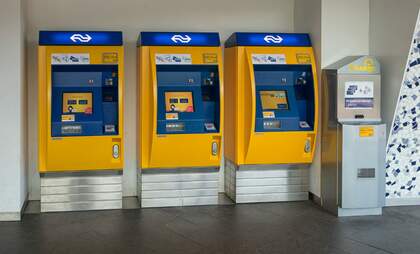How the OV-chipkaart works in the Netherlands
A new public transport system in a new country can be extremely daunting. Not to worry, after reading this you should have some clarity on the matter that is the Dutch public transport system and the OV-chipkaart.
First things first...
So, you want to use public transportation in the Netherlands. Well, the first thing you will need is an OV-chipkaart! Of course, if you are only here for a holiday and will be walking around and only occasionally using trams, buses or metros. there is not much point in getting an OV-chipkaart.
However, if you plan on being here for a while, then getting a card you can use to jump on a bus or train when you like is pretty handy. There are different types of OV-chipkaart you can buy and use, namely the anonymous one and the personal one. This excludes the disposable OV-chipkaart often used by tourists.
The difference between the personal and anonymous OV-chipkaart
So, you’re here for a longer period of time and want to get a travel card - but which is best for you?
Anonymous OV-chipkaart
The anonymous OV-chipkaart is not linked to your personal details and therefore where and when you travel is not connected to you directly. This also means that the anonymous card can be used by everyone; however, not at the same time.
This type of transport card does have a few drawbacks though. For one, you can’t block it if you lose it or it’s stolen. So, if you happen to drop it by accident, the money you put on there is also gone, and as it does not contain your personal information, there is no way to get it back to you.
Also, you can’t buy a subscription (i.e.for discounted travel) and load it onto this type of card, and you can’t set it to automatically top itself up with credit via your bank account.
Personal OV-chipkaart
A personal OV-chipkaart is linked to your personal details, which means that you can easily claim back for delayed journeys and block your travel card if you accidentally lose it or it is stolen. Also, as you can see your travel history, making it easy to declare these costs to your employer if necessary.
With a personal OV-chipkaart, you can also benefit from various subscriptions which you can load onto your card, such as travelling at a 40 percent discount outside peak hours. Another service you can use if you have a personal OV-chipkaart is an OV-bike. This is a free subscription you can load onto your card; of course, using the bikes does cost a certain amount of money per day that you use it.
What do the cards cost and where can you buy them?
Both cards cost the same: 7,50 euros. However, the anonymous card can just be bought, but the personal one must be applied for. This can be done via an online form, but you will need a Dutch address and bank account. If you want to go out and buy an anonymous OV-chipkaart, you can do so at various supermarkets, certain Bruna shops, and train stations.
You’ve got a public transport travel card - now what?
Now that you’ve purchased your preferred OV-chipkaart, how do you use it? Well, first things first, you will need to top it up to use it. You can’t top it up everywhere, so it is a good idea to make sure you do so before using the tram for instance, as there will not be a top-up point at each stop.
At train stations, you will almost always be able to find a top-up station - one of those big yellow and blue Nederlandse Spoorwegen (NS) machines. At most metro stations you will also be able to find top-up machines, usually from the metro provider, for example, GVB.
Top it up by scanning it and then choosing one of the top-up options and paying with either cash or card. On the NS machines, you can choose to top up just enough for a specific route if you like, or choose the option to load your pre-purchased subscription onto your personal OV-chipkaart.
To travel on the train with either a personal or anonymous OV-chipkaart, you will need a minimum of 20 euros on your card. If you have a subscription loaded onto your personal card, this is reduced to 10 euros. Other transport providers use different check-in tariffs.
OVpay: Using your debit card to travel on Dutch public transport
If you're not too fussed about getting an OV-chipkaart, you might be wondering whether it's also possible to pay for your travels using a contactless debit or credit card. The answer to this question is yes!
It took a while, but now no matter where you are in the Netherlands or which mode of transportation you're using, you can simply check in and out using contactless payment systems on your mobile phone, smartwatch, or credit or debit card. While incredibly practical - especially for tourists who don't want to have to worry about buying tickets - the system doesn't allow you to make use of any subscriptions you may have. For that, you'll still need a personal OV-chipkaart (for now at least).
You’re ready to travel through the Netherlands!
Now that you’ve taken care of getting an OV-chipkaart and topping it up, it’s time to explore the Netherlands via public transport! Don’t forget that you will need to check in at the start of your journey and check out at the end.
If you change providers or types of transport (train, bus etc.), you will need to check out of the first one and check in to the next one, for example, checking out of the train to switch to the metro. You can use your OV-chipkaart to travel on all public transport in the Netherlands.



COMMENTS
Leave a comment
Rajarshi Rakesh... 05:17 | 29 August 2018
Gary Hewitt 11:15 | 30 August 2018
GergelyKosztolányi2 14:34 | 10 September 2020